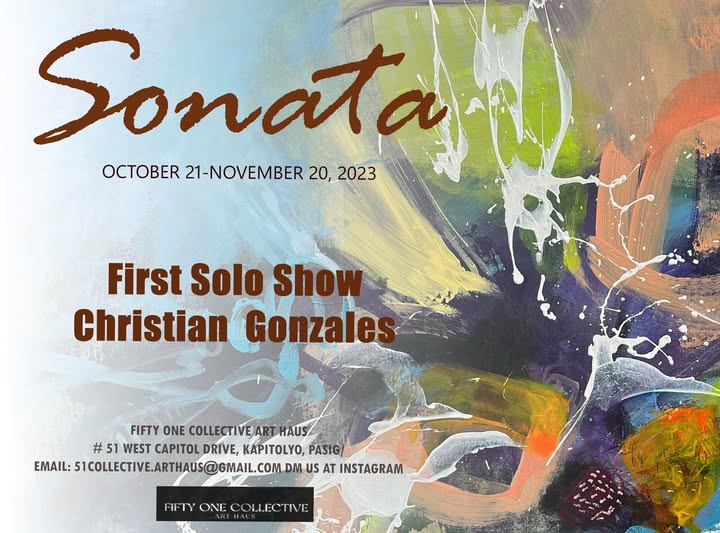October 21-November 20, 2023
Fifty One Collective Art Haus
Mandaluyong, Metro Manila
Music marked Christian Gonzales’s passage back to his childhood passion: painting. In 2015, he flew to Europe to sing for a company event. This vocal performance allowed him to express his creative spirit amidst the humdrum of his corporate day-to-day work. Four years after his initial visit, he went back to Europe for another work trip where he spent his weekends admiring the locality’s art and architecture. Among the sights he took in, his encounter at the Louvre Museum was momentous in particular as it ultimately reignited his pulse to create. And so, in 2020, he painted again.
From the Italian word sonare – meaning “to sound” – sonata is a piece played by one or more instruments. Cantata, in contrast, is meant to be sung. In a way, the dichotomy mirrors the artist’s choice of creative instrument: from voice to paintbrush. Still, music was in the background as he made the artworks for his first solo exhibit. Piano compositions particularly trickled inspiration, flowing from his imagination to his brush’s bristles, finally resulting in vivid colors and fluid movements in his canvases. This symbiosis in Gonzales’s artistic process evokes a quote from German composer Ludwig van Beethoven, the mind behind the famous Moonlight Sonata, in which his remark about music can also be said about art in general: “Music is a higher revelation than all wisdom and philosophy. Music is the electrical soil in which the spirit lives, thinks and invents.”
Like how sonatas are typically made of three movements or sections, the artworks in Gonzales’s Sonata can be divided into three styles: full abstraction, realism through his ballerina figures, and a mix of the two. The abstract is where the artist personally feels limitless in his creative language. His expression can be energetic as seen in the “Changing Seasons” series, or temperate like “Luminous Terrain,” or geomorphic like “Tulip Fields.” While Gonzales finds comfort in abstraction, he does not shy away from a dash of realism through the mannequin-like figures of his graceful ballerinas. The dancers in the “Alpine Dandelion” or “White Daisy” series are captured mid-action, their elongated arms and feet en pointe frozen in scene, in the brink of completing their move. The danseuses in “Maple Birds” or “Courtyard Roses” also embody this dynamism but with a heightened abstraction on their clothes, at one point even extending to the bodies themselves such as the ones in “Prima Aurora.” Looking back to the zestful white splotches on “Changing Seasons,” one might perceive them as human figures – perhaps a deconstruction of the dancing ballerinas? Nevertheless, as with any abstraction, it is open to interpretation.
In his first solo exhibit, Gonzales is still in sonata-allegro: the beginning. While he has yet to reach his crescendo, Sonata marks an andante in his artistic career: a steady pace forward. Here, his overture unveils a changing of the seasons, a celebration of diversity; his melodies harmonize a mélange of colors and shapes; his rhythm dances in abstract pieces and ballerina figures.
These are what his creativity currently sings about.
More info: Fifty One Collective Art Haus Facebook · Fifty One Collective Art Haus Instagram
